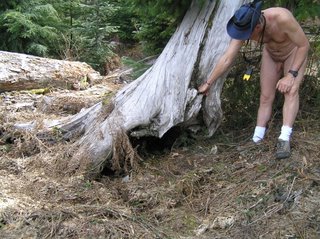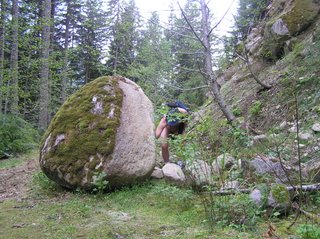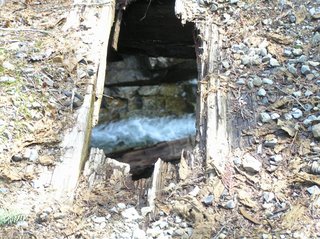Beginner Nude Hiker?
Just a few simple ideas to make that first hike good:
Firstly, relax and don't worry too much. Most people you inadvertently meet on the trail are of the tolerant sort and encountering a nude hiker isn't totally unheard of. You do want to be considerate and prudent so . . .
- Pick the lesser used trails (good resource is the Forest Service listings, link in the Sidebar)
- Do your hiking on a weekday when trails are not as well used (if at all)
- Hike the back Forest Service roads that do not service trailheads (again, check the maps and the Forest Service) . . . old logging roads make great nude hiking areas
- Pick a trail that only has one trailhead versus one that has trailhead at both ends. That way you won't be surprised by someone hiking in from the other direction
- Cars at the trailhead usually means that someone is on the trail . . . no cars and no trailhead at the other end and you can confidently hike in nude knowing that no one is on the trail ahead of you
- Learn to open your senses and be observant. Tracks? Are they old or fresh? Spider webs across the trail? All are signs of recent activity or the lack of it.
- Hike in the first mile clothed or ready to clothe. After the first mile you see very few hikers as most just give up. Those you might meet are often just like you or very tolerant.
- If your senses are open to the surroundings you should be able to hear or see someone approaching long before your nudity is apparent. Out of consideration, slip on a pair of shorts.
- Always clothe yourself if there is a chance of encountering children on the trail. Likewise, before going through a campground on a trail, slip on some shorts.
- Simple nudity is no illegal in National Forests in this region (Region Six, the Pacific Northwest). That does not make nudity legal, though. If you are told to clothe up by a ranger, do so. Lewd behavior is illegal and will get you cited should someone complain.
- Simple Nudity is prohibited by rule in the National Parks except where permitted by notice (such as the pool area immediate to Olympic Hot Springs in Olympic national Park.
- All nudity is illegal in Washington State Parks.
- On Department of Natural Resources (DNR) lands, nudity is treated much in the same way as the National Forests.
- On encountering someone on the trail, short up only if you can do so without looking panicky and stupid. Otherwise it's just best to grin and bare it. You'd be surprised how few people even care. Try putting your shorts on before hiking: Can you do it with a backpack on? Will they even slip over your hiking boots or are you going to end up rolling down the slope with one foot stuck in them. I've taken to putting my shorts out of reach on some of the more remote trails. On the few occasions I've encountered people, just knowing there is no way to get those shorts out of the pack and get them on, makes it easy to stand my ground and hike nude as if it were the most natural thing in the world . . . which it is. After a few times of that, being nude and staying nude becomes second nature. Encounters rarely bother me.
- Hiking in the mountains brings you that much closer to damaging ultraviolet rays at altitude. And there are some parts of you that have seen very little exposure to sunlight. Use sunblock, especially if you are fair-skinned and subject to sunburning. The pump-spray type of sunblock works best if you are alone and need to protect your back. Remember to re-apply it if you have been sweating a lot or have gone skinny-dipping.
- Moisturize your skin! The environment will dry it out and make your skin vulnerable to cuts and scratches, poison oak (little in the west side of the Cascades), stinging nettles and bugs. If your skin is hydrated and in good condition it will stand up well to these assaults.
- Do not hike at dawn or at dusk. These times are the favorite feeding times for mosquitoes and no-see-ums. DEET is the most effective insect repellent around but it is deleterious on the skin and is probably systemically poisoning us. Use DEET sparingly. Spray you pack instead and attach several repellent wipes to the pack and your hat. All biting insects are attracted to the carbon dioxide we breathe out . . . that's why they hang out around the tailpipe of a running motor.
- Horse Flies (attack the legs) and Deer Flies (attack the head) are vicious nasty biting pests. Learn their habits and favorite areas so you can avoid them. Do not use fragarent or fruity aftershaves or frangrances as these attract insects, not to mention bears.
- If your skin is adequately moisturized you will stand up to temperature changes better. Hiking produces a huge amount of heat energy which is dissipated easier when nude. But likewise, when you stop moving your body is still radiating that heat away into the environment. Learn your limits on exposure and the warning signs of hypothermia (too cold) or hyperthermia (too hot). Vitamin B6 and acclimization will boast your basal celluar metabolism enabling you to withstand the cold a little longer . . . most people can withstand 50F indefinitely without slipping into hypothermia . . . you are putting out enough heat to balance what is lost. B6 and acclimization can take you down into the low 40s.
- Conversely, hyperthermia is overheating, usually excaberrated by loss of electrolytes from sweating and a thickening of the blood (heat exhaustion). Strangely, it is more a problem for nude hikers because we have more skin exposed to evaporate sweat into the air and thus we can slip into heat distress without much warning (the first warnings you will get are the cramps and general muscle weakness). Bring plenty of water with you and drink it. A sage saying goes that if you are peeing clear, you are hydrated sufficiently. If not, then you are not drinking enough water. Getting into the habit of sipping as you hike. If you are already thirsty, you are dehydrated. Carry salt tablet or a rehydration pack. If you desire salt, trust your body . . . it's asking for those electrolytes.
- Avoid coffee and colas. I love coffee and I ignore this rule, but coffee is a diuretic . . . it makes your kidneys work overtime in pulling water from your bloodstream. Your going to piss more! Same with alcohol.
- Hiking in the mountains can use 4-6,000 calories a day. Carb load yourself the day before.
- Avoid a large meal before or during a hike. Digestion uses up to 60% of your available energy output to digest that meal . . . energy that is not available for hiking. Stick to small snacks or high carb/high protein. Chocolate is the hikers lifesaver . . . there is a lot of energy in a simple chocolate bar.
- Carry a couple of runner's glucose gel packs for immediate energy when needed.
- Avoid flatulent foods such as eggs, animal fats, the cabbage family. The produce gas and sometime painful cramps or explosive decompression as you gain elevation.
- Wear a hat. Make it light-colored . . . deer flies like dark colors.
- Wear sunglasses. The sun is very bright up top . . . especially if you come onto a pristine alpine snowfield.
- Carry an emergency poncho in a pouch. The weather turns on a dime in the mountains.
- Wear the best pair of hiking shoes or boots that money can afford. Your feet have to get you in there and back out again. Wear two pairs of socks so that the inner pair slide against the outer pair to minimize blisters. The pairing also acts as a wick to move moisture away from your feet. Carry a spare pair of socks. Clip your toenails. If you don't and they cramp against the toe on the downslope you aren't going to want to hike too far.
- Carry a least a few bandaids and a styptic pencil (the type shaver's use) to take care of minor scratches and cuts before the biting insects are attracted to the fresh blood. Consider at least a small first aid kit in your fanny pack or backpack
- Let someone know where you're going and the time you're expected to check back in. If there is a chance of getting lost, carry maps and a compass . . . maybe a GPS unit. Carry your cell phone. It might work, especially on the higher ridges. Carry something that can act as a signaling mirror. Always, always, carry something reliable with which to make a fire that may save your life.
- Have a good hiking staff or pole. Mine is a piece of deadfall I picked up year ago and I love it.
- Bears aren't much of a problem. They're shy creatures. But I still carry bear deterrent . . . it's very effective . . . especially on the two-legged variants.
Rick


























